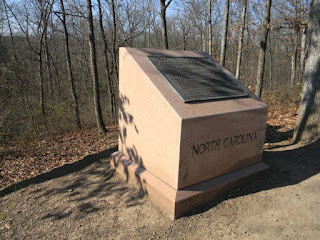I recently learned that there were 412 infantry regiments engaged at the battle of Gettysburg. 238 of these were Union and 174 were Confederate. It made me wonder about particular regiments and how each one was full of individuals with their own lives and dreams, many of which would never be realized. Today I chose to feature the 49th Pennsylvania Infantry. The choice isn’t random --- one of my close relatives fought in this unit. Though this particular soldier wasn’t at Gettysburg, I’m sure he knew many of the men who were.
The 49th Pennsylvania fought in a rather out-of-the-way place, at least if you take the major tour stops of the Gettysburg battlefield into consideration. Their location was along present-day Howe Avenue. They didn’t play a particularly dramatic part in the fight, but they were partially responsible for shoring up the Fifth Corps’ center on July 2nd. On July 3rd the regiment helped to defend the round tops. Then as now, the 49th’s position was marked by Taneytown Road. They weathered roaring cannons on the third day of battle and remained relatively untouched. The 49th was thus able to say that their regiment marched out with the same number of men who marched in. This was a blessing few other units had.
It is interesting to note that, according to the “PA Roots” website, members of the 49th were posted at Devil’s Den on July 4th to canvas the area and provide resistance to any remaining Confederate threats that might arise. This seems odd considering that the battle had ended on the 3rd. The Army of the Potomac wasn’t taking any chances. On a modern note, anyone wishing to visit the 49th Pennsylvania monument can turn right off of Sykes Avenue (the main tour road at Little Round Top) and past the 20th Maine position; right onto Wright Avenue, which curves; across Taneytown Road / Route 134; and onto Howe Avenue.
My relative wasn’t yet a member of the 49th Pennsylvania during the 1863 Gettysburg Campaign, but I still wanted to feature him. His name was Isaac Riegel (also spelled Riegle, Reigel, and Riggle) and he was only seventeen years old when he enlisted in Co. I on February 26, 1864. His service records describe him as gray-eyed and brown-haired, with a fair complexion, and his height was 5 feet 8 inches. Seventeen was the last age he would ever reach. Isaac was killed on May 10, 1864 at Spotsylvania Court House, Virginia, just three months after his enlistment. His burial site is unknown. It may be that he was never moved off the battlefield or that he is buried in an unmarked grave in the Fredericksburg Cemetery. Whatever the truth, I am extremely proud to call him my kin.
**HONORED TODAY**
PVT. W. RILEY ALLEN
Co. E, 2nd South Carolina Infantry
Died July 01, 1863
Pvt. Allen was one of many South Carolina boys for whom George Rose’s farm was an initial burial place. He was laid to rest beneath a cherry tree until his final journey to Magnolia Cemetery in Charleston.
(c) 2013 Skies of Blue and Gray























